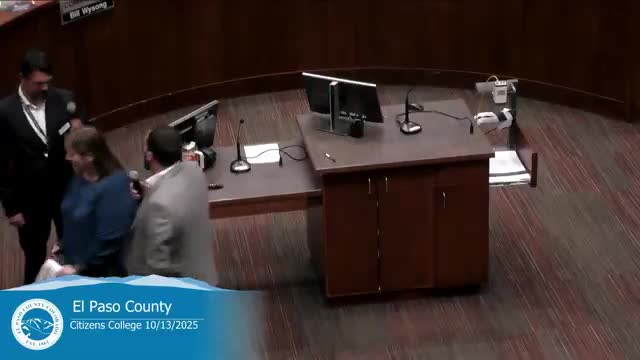El Paso County planning staff outline land-development code update, "place types" master plan and enforcement work
October 17, 2025 | El Paso County, Colorado
This article was created by AI summarizing key points discussed. AI makes mistakes, so for full details and context, please refer to the video of the full meeting. Please report any errors so we can fix them. Report an error »

Planning staff members Joseph Letke and Ryan Hauser told Citizen College participants that the county is updating its 2007 land development code to reflect modern uses such as short-term rentals and breweries, and to close gaps between market trends and the code.
Letke emphasized that the county�s 2021 Your El Paso County Master Plan uses "place types" rather than a conventional future-land-use map; place types are intended to match land-use patterns and geographic features so staff can evaluate whether proposed projects fit surrounding character. "In order to potentially rezone this property, we�ll look at the place type and say, well, the first criteria point for a rezone application is that it be consistent with the master plan and the place type," he said.
Subdivision review and water sufficiency Letke and Hauser explained the multi-step review process for subdivisions: an early-assistance meeting, referral to stakeholders (county attorney, health department, CDOT where applicable), public notice, planning commission recommendation, and final consideration by the Board of County Commissioners. The presenters said the county requires water sufficiency for subdivisions in excess of state minimums: "Per the state of Colorado, subdivision applications are required to have sufficient water for a hundred years," Hauser said, adding that "El Paso County... expands that to 300 years" for county approvals.
Code update and public input Hauser said the county is working with a consultant to update the land development code and that public feedback is part of the process; he said Module 1 is available on the county website and further modules and dates will be announced through planning staff channels.
Code enforcement and homeless camps Kurt Arnold, code enforcement supervisor, described the department�s civil, complaint-driven enforcement process and presented caseload figures used in enforcement planning. He said the county averages about 1,250 code-enforcement cases a year and currently has roughly 138 active cases, about 34 cases in litigation and that the office handled about 70 homeless-camp cases this year. Arnold showed before-and-after photos of property abatements and said the department uses abatement warrants when owners do not remove hazardous conditions.
Why it matters: The presentations laid out the local rules and review processes that shape development, protect public health and safety, and govern what landowners can do with property. The master plan�s place-type framework and the upcoming code update will influence what types of projects are considered compatible in different parts of the county.
Ending: Planning staff closed by offering contact information and by reminding attendees that major land-use applications are accompanied by public notice and hearings at both the planning commission and the Board of County Commissioners.
Letke emphasized that the county�s 2021 Your El Paso County Master Plan uses "place types" rather than a conventional future-land-use map; place types are intended to match land-use patterns and geographic features so staff can evaluate whether proposed projects fit surrounding character. "In order to potentially rezone this property, we�ll look at the place type and say, well, the first criteria point for a rezone application is that it be consistent with the master plan and the place type," he said.
Subdivision review and water sufficiency Letke and Hauser explained the multi-step review process for subdivisions: an early-assistance meeting, referral to stakeholders (county attorney, health department, CDOT where applicable), public notice, planning commission recommendation, and final consideration by the Board of County Commissioners. The presenters said the county requires water sufficiency for subdivisions in excess of state minimums: "Per the state of Colorado, subdivision applications are required to have sufficient water for a hundred years," Hauser said, adding that "El Paso County... expands that to 300 years" for county approvals.
Code update and public input Hauser said the county is working with a consultant to update the land development code and that public feedback is part of the process; he said Module 1 is available on the county website and further modules and dates will be announced through planning staff channels.
Code enforcement and homeless camps Kurt Arnold, code enforcement supervisor, described the department�s civil, complaint-driven enforcement process and presented caseload figures used in enforcement planning. He said the county averages about 1,250 code-enforcement cases a year and currently has roughly 138 active cases, about 34 cases in litigation and that the office handled about 70 homeless-camp cases this year. Arnold showed before-and-after photos of property abatements and said the department uses abatement warrants when owners do not remove hazardous conditions.
Why it matters: The presentations laid out the local rules and review processes that shape development, protect public health and safety, and govern what landowners can do with property. The master plan�s place-type framework and the upcoming code update will influence what types of projects are considered compatible in different parts of the county.
Ending: Planning staff closed by offering contact information and by reminding attendees that major land-use applications are accompanied by public notice and hearings at both the planning commission and the Board of County Commissioners.
View full meeting
This article is based on a recent meeting—watch the full video and explore the complete transcript for deeper insights into the discussion.
View full meeting
